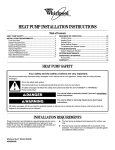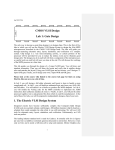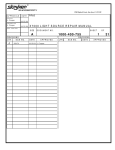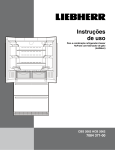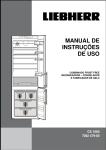Download RefPlus LS-LP-LA-LV SERIES Specifications
Transcript
INSTALLATION, OPERATION WALK-IN COOLERS SERIES LS-LP-LA-LV 1 & MAINTENANCE INSTRUCTIONS INSTALLATION, OPERATION & MAINTENANCE INSTRUCTIONS CONTENTS SERVICE . . . . . . . . . . . . . . . . . . . . . . . . 5 INSPECTION . . . . . . . . . . . . . . . . . . . . . . . . 5 CLEANING. . . . . . . . . . . . . . . . . . . . . . . . . 5 SAFETY CONSIDERATIONS . . . . . . . . . . . . . 3 INTRODUCTION . . . . . . . . . . . . . . . . . . . 3 INSTALLATION STEP 1 – COMPLETE PRE-INSTALLATION CHECKS . STEP 2 – LOCATION . . . . . . . . . . . . . . . . STEP 3 – MOUNTING . . . . . . . . . . . . . . . . STEP 4 – CONNECT DRAIN LINE . . . . . . . . . STEP 5 – REFRIGERANT CONNECTIONS . . . . . . STEP 6 – EXPANSION VALVE CONNECTION . . . . STEP 7 – WIRING . . . . . . . . . . . . . . . . . START-UP LEAK TESTING AND EVACUATION . . . . . . . . FAN MOTOR . . . . . . . . . . . . . . . . . . . FAN DELAY DEFROST TERMINATION CONTROL . FAN DELAY DRAIN PAN CONTROL . . . . . . . CHECK SUPERHEAT . . . . . . . . . . . . . . . . DEFROST SYSTEM . . . . . . . . . . . . . . . . . . . . . . . . . . . . . . UNIT SPECIFICATIONS . . . . . . . . . . . . . . . 6 3 3 3 3 4 4 4 TROUBLESHOOTING CHART. . . . . . . . . . . . 6 TECHNICAL DATA . . . . . . . . . . . . . . . . . . . . . 7 TECHNICAL DATA (CONT’D) . . . . . . . . . . . . . . . 8 REFRIGERATION SYSTEM START-UP CHECK LIST . . . . . . . . . . . . . . . . . 10 WARRANTIES . . . . . . . . . . . . . . . . . . . . 11 . . . . . . . . . . . . . . . . . . . . . . . . 4 4 4 4 4 5 NOMENCLATURE L L = Low S = Silhouette P = Profile A = Air S A 224 1 — 1 1 = 120/1/60 2 = 240/1/60 5 = 208-240/3/60 8 = 600/3/60 9 = 480/3/60 Product Generation A = Air Defrost E = Electric Defrost G = Reverse Cycle Hot Gas Defrost W/Electric Heated Drain Pan H = Three Pipe Hot Gas Defrost W/Electric Heated Drain Pan R = Reverse Cycle Hot Gas Defrost T = Three Pipe Hot Gas Defrost 2 Unit Capacity @ 10oF T.D. 22,400 Btu/hr INSTALLATION, OPERATION & MAINTENANCE INSTRUCTIONS SAFETY CONSIDERATIONS INSTALLATION Installing, starting up, and servicing equipment can be hazardous due to system pressures, electrical components and equipment location (roofs, elevated structures, etc.). Only trained, qualified installers and service mechanics should install, start up, and service this equipment. STEP 1 COMPLETE PRE-INSTALLATION CHECKS Examine for damage incurred during shipment. File a claim immediately with transit company if damage is found. Verify that the nameplate electrical requirements match the available power supply. Check the shipment for completeness. When working on the equipment, observe precautions in the literature and on the tags, stickers, and labels attached to the equipment. Follow all safety codes. Wear safety glasses and work gloves. Keep quenching cloths and fire extinguisher nearby when brazing. Use care in handling, rigging, and setting bulky equipment. WARNING Before installation, always check to be sure main power to systems is OFF. Electrical shock can cause personal injury or death. STEP 2 - LOCATION All unit coolers should be installed flush against the ceiling. The unit cooler must be level in all directions to ensure proper drainage of condensate. Be sure there is sufficient clearance between the ceiling and unit cooler to allow for cleaning the unit cooler top. When deciding on the location of the unit cooler, consider the following: STEP 3 - MOUNTING Most unit coolers can be mounted with either bolts or rod hangers. Use 5/16 in. bolts and washers for unit coolers weighing up to 250 pounds. Use 3/8 in. bolts and washers for unit coolers weighing from 250 to 500 pounds. For unit coolers over 500 pounds, use 5/8 in. bolts and washers. NOTICE The unit cooler must be mounted level for proper condensate draining. Adequate support must be provided to hold the weight of the unit cooler. Note: The area above the unit must be sealed and accessible to facilitate hand cleaning without the use of tools in order to comply with National Sanitation Foundation (NSF) Standard 7. • Location of aisle racks • Location relative to compressor for minimum pipe runs • Location of condensate drains for minimum run INTRODUCTION • The air pattern must cover the entire room These instructions describe installation, start-up, and service for the RefPlus refrigeration unit coolers. • Never locate unit coolers over doors or door openings • Allow sufficient space between rear of unit cooler and wall to permit free return of air NOTE Avoid placement of the unit cooler directly above doors and door openings where low temperature is being maintained. Position the unit cooler so the discharge air blows above the doors. Install a baffle if door extends above the blower level. LS UNIT COOLERS – These unit coolers should be located in a position where the air discharge is toward the door. The coil face on the unit cooler should be least 7 in. away from the wall. LP & LA UNIT COOLERS – These unit coolers should be located in the center of the cooler with air discharge toward the back or side wall. STEP 4 - CONNECT DRAIN LINE For all unit coolers, a drain line union is recommended for ease of installation and future servicing and should be located in close proximity to the drain pan. LS, LP & LA UNIT COOLERS – A 7/8 in. ID removable drain fitting is supplied with each unit. Follow steps 1 through 4 above for connecting the drain line. FOR ALL UNIT COOLERS, connect the drain line as follows: 1. Replace the rubber gasket to prevent condensate leakage. 2. Locate the union as close to the drain pan as possible. 3. Using two wrenches, tighten the drain fitting. The use of two wrenches prevents the drain fitting from twisting and damaging the unit cooler. 4. Sharply pitch the drain line and exit it through the cooler with a short run. 5. Insulate and seal the drain line where it passes through the wall. NOTE Unit coolers with electric defrost require a 20 in. clearance at the left end when facing the fans to allow removal of defrost heaters. 6. Locate the drain traps in warm ambient air temperature to prevent freeze up. NOTE If the cooler temperature is below 32ºF, a field supplied drain line heater (15 W per foot) may be required. When installing the heater, be sure to avoid overlapping. 3 INSTALLATION, OPERATION & MAINTENANCE INSTRUCTIONS Drain traps on low temperature unit coolers must be outside of refrigerated enclosures. In the instance where traps are subject to freezing temperatures, wrap the traps with heat tape and insulation. Always trap drain lines individually to prevent vapor migration. STEP 5 - REFRIGERANT CONNECTIONS All refrigerant system components must be installed in accordance with applicable local and national codes using proper engineering practices. Use top quality refrigeration tubing that is internally free of dirt, humidity or other contaminants. Unsealed tubing should not be used. Long radius elbows are recommended. Dry nitrogen must be swept through the lines while joints are brazed to avoid oxidation and carbon deposits. IMPORTANT The use of a calibrated pressure gauge and regulator must always be used with nitrogen gas cylinders. All external piping must be well supported. The unit cooler will not support external piping or valves. If the condition arises where the suction line must be raised to a point higher than the suction connection on the unit cooler, a suction line trap must be installed on the unit cooler. Horizontal suction lines should slope away from the evaporator toward the compressor. Leak check and evacuate the system using a two-stage deep vacuum pump. STEP 6 - EXPANSION VALVE CONNECTION All unit coolers are supplied with a 1/2 in. OD sweat expansion valve connection. Expansion valves are field supplied. LS, LP & LA unit coolers require the use of an externally equalized expansion valve and are provided with a 1/4 in. OD equalizer line. Check the operation of the expansion valve after the system has reached the desired cooler temperature. If the coil is not receiving enough refrigerant, reduce the superheat setting on the expansion valve. 4 To ensure unit cooler performance, the expansion valve must be set at the proper superheat and at the lowest temperature in which the system is expected to operate. FAN DELAY DEFROST TERMINATION CONTROL This control located on the coil plate senses the coil temperature. To provide fan delay, the defrost thermostat must be turned off. 1. Set thermostat between 20ºF and 30ºF or above. STEP 7 - WIRING All systems wiring must be in compliance with all applicable local and national codes. All internal wiring of fan motors, tubular heaters and combination defrost termination fan delay control have been factory connected. All wiring connections terminate on a single terminal block in the wiring compartment and are clearly labeled. START-UP CAUTION Before starting unit cooler, be sure wire fan guards are secured in place over each fan. LEAK TESTING AND EVACUATION Leak testing and evacuation must be done in accordance with local and national codes. Once all refrigerant connections are made, leak test all joints before charging the system with refrigerant. After leak testing, all moisture and non-condensable gas must be evacuated from the system. Attach high vacuum line pump and gauge on both high and low pressure sides of the system. A minimum vacuum level of 100 microns is required to effectively remove moisture. Be sure all valves such as compressor, hot gas, receiver, and liquid solenoid valves are open. Break the vacuum in the system with the refrigerant to be used. Always charge the refrigerant into the system through a new 16 cu. in drier (field supplied) in the charging manifold line. FAN MOTOR The fan motor may restart on automatic thermal protection if the coils are frozen. The fan motor may cycle if the coil is blocked. Check the supply voltage at the motor leads if motor is inoperable. 2. Adjust defrost timer up to maximum of 45 minutes. 3. Set the thermostat between 55 to 60ºF to defrost unit coolers operating between –40 to –20ºF. To defrost unit coolers operating between –10 to 10ºF, set the thermostat between 60 to 65ºF. FAN DELAY DRAIN PAN CONTROL The fan delay drain pan control senses the general coil temperature. • With temperature rise, the fan delay thermostat de-energizes the fan and energizes the electric pan heaters. • After defrost cycle, the coil temperature drops and the fan delay thermostat energizes the motor and de-energizes the heaters. • Defrost timer must be set long enough to completely melt the ice in the unit cooler. Set the thermostat at 20 to 25ºF and the differential at minimum. IMPORTANT After correcting a faulty defrost cycle, it is essential that the coil, drain pan and unit cooler be free and clear of ice before placing the unit cooler back on automatic operation. CHECK SUPERHEAT After the temperature has reached the desired temperature, the unit cooler superheat should be checked and adjustments made if necessary. Generally, systems with a design temperature difference (TD) of 10ºF should have a superheat value of 6 to 10ºF for maximum efficiency. For systems operating at higher TD, the superheat can be adjusted to 12 to 15ºF as required. INSTALLATION, OPERATION & MAINTENANCE INSTRUCTIONS NOTE Minimum compressor suction superheat of 20ºF may override these recommendations on some systems with short line runs. DEFROST SYSTEM SERVICE AIR DEFROST UNIT COOLERS: Fan motors run continuously and a defrost time clock or low-pressure setting stops the compressor when defrost is required. INSPECTION After one day of operation, check for any vibration in the unit cooler. All unit coolers should be checked at least once a month for proper defrosting. It may be necessary to periodically change the number of defrost cycles or adjust the duration of defrost. NOTE WARNING If the condensing unit does not have flooded condenser head pressure control, then the condensing unit must have discharge pressure above the equivalent 105ºF condensing pressure. To properly determine the superheat of the unit cooler, follow the steps below: 1. Measure the temperature of the suction line at the point where the bulb is secured. 2. Determine the suction pressure in the suction line at the bulb location by using one of the following methods : A) Placing a gauge in the external equalized line. B) Placing a gauge directly in the suction line near the unit cooler or directly in the suction header of the unit cooler. 3. Convert the pressure reading to saturated unit cooler temperature by using a temperature pressure table. See table # 1. The unit cooler must not be in operation more than 16 hours per day. ELECTRIC DEFROST UNIT COOLER: A time clock starts the defrost process by stopping the fan and energizing the heaters. When the defrost thermostat resets the time clock, it de-energizes the heaters and re-starts the fan motors. REVERSE CYCLE HOT GAS DEFROST UNIT COOLERS: Reverse cycle defrost systems introduce compressor discharge gas through the suction line during defrost. The amount of gas introduced is controlled by a solenoid bypass valve and a gas defrost time clock. Condensed refrigerant is relieved through a check valve. The check valve bypasses the expansion valve leading to the liquid line which has reduced pressure. The drain pan is warmed by the entering hot gas to avoid freezing. Defrost is initiated and terminated by the time clock. An alternate method to determine superheat of the unit cooler can be used : 1. Measure the temperature of the suction line at the point where the bulb is secured (outlet). 2. Measure the temperature of one of the distrib- utor tubes close to the unit cooler coil (inlet). 3. Subtract the inlet temperature from the outlet temperature. The difference is superheat. NOTE This method will yield accurate results as long as the pressure drop through the unit cooler coil is low. 1. Check all wiring and insulators. 2. Check and tighten all electrical connections. 3. Inspect contactors for proper operation and for worn contact points. 4. Check all fan motors. Tighten motor mount bolts/nuts and tighten fan set screws. 5. Clean condenser coil surface. 6. Check refrigerant and oil level in the system. 7. Check operation of the control system ensuring all safety controls are operating properly. 8. Check all defrost controls are functioning properly. 9. Clean the unit cooler coil surface. 10. Clean the drain pan and check the drain pan NOTE Using a suction to liquid heat exchanger is recommended. 4. Subtract the saturated temperature from the actual suction line temperature reading. The difference is superheat. Under normal usage conditions, proper unit cooler maintenance should be done every six months to include the following: drain line for proper drainage. 11. Check drain line heater for proper operation, cuts and abrasions. 12. Check and tighten all flare connections. THREE PIPE HOT GAS DEFROST UNIT COOLERS: During defrost, compressor discharge gas is introduced in a separate hot gas line. The amount of gas introduced is controlled by a solenoid bypass valve and a gas defrost time clock. To avoid excessive accumulation of liquid in the suction accumulator, a heat exchanger is recommended. The drain pan is warmed by the entering hot gas to avoid freezing. The time clock cycles fan motors, liquid and hot gas solenoids. NOTE A field-installed pressure regulating valve may be required on low temperature systems to control compressor crankcase pressure. See troubleshooting chart for troubleshooting information. IMPORTANT Do not use alkaline or acidic solutions; they will damage the coils. Remove the fan guard to clean the inner face of the fan coil. CLEANING The unit cooler should be checked periodically for dirt accumulation. Grease and dust should be removed from the fan, fan guards, and drain pan. Occasional cleaning of finned surfaces can be done by dusting the fins and then cleaning with a mild detergent and warm water spray. Always pressure clean in reverse of the air flow. INSTALLATION, OPERATION & MAINTENANCE INSTRUCTIONS UNIT SPECIFICATIONS FOR ALL UNITS: - For R-134a or R-22 refrigerant charge, multiply R-404 by 1.09. - Operating charge is based on 30% liquid and 70% vapor at 25ºF suction. LS SERIES: - Use LSR model for hot gas reverse cycle defrosts. - Use LST model for hot gas three pipe defrost with gas drain pan. - Air throw for LS Series: 25 to 35 feet. LP SERIES: - Use LPG model for hot gas reverse cycle defrost with electric drain pan. - Use LPH model for hot gas three pipe defrost with electrical drain pan. - Air throw for LP Series: 12 to 18 feet on each side. LA SERIES: - Use LAG model for hot gas reverse cycle defrost with electric drain pan. - Use LAH model for hot gas three pipe defrost with electric drain pan. - Air throw for LA Series: 10 to 15 feet on each side. TROUBLESHOOTING CHART 6 SYMPTOMS POSSIBLE CAUSES POSSIBLE CORRECTIVE STEPS Fan(s) will not operate 1. 2. 3. 4. 5. 6. Main switch open Blown fuses Defective motor Defective timer or defrost thermostat Unit in defrost cycle Coil does not get cold enough to reset thermostat 1. Close switch 2. Replace fuses. Check for short circuits or overload conditions. 3. Replace motor 4. Replace defective component 5. Wait for completion of cycle 6. Adjust fan delay setting of thermostat Room temperature too high 1. 2. 3. 4. Room thermostat set too high Superheat too high System low on refrigerant Coil iced-up 1. Adjust thermostat 2. Adjust thermal expansion valve 3. Add refrigerant 4. Manually defrost coil and check defrost controls for malfunctions Ice accumulating on ceiling around evaporator and/or on fan guards, venturi, or blades 1. 2. 3. 4. Defrost duration is too long Fan delay not delaying fans after defrost period Defective defrost thermostat or timer Too many defrosts 1. Adjust defrost termination thermostat 2. Defective defrost thermostat or not adjusted properly 3. Replace defective components 4. Reduce number of defrost Coil not clearing of frost during defrost cycle 1. Coil temperature not getting above freezing point during defrost 2. Not enough defrost cycles per day 3. Defrost cycle too short 4. Defective timer or defrost thermostat 1. Check heater operation 2. Adjust timer for more defrost cycles 3. Adjust defrost thermostat or timer for longer cycle 4. Replace defective component Ice accumulating in drain pan 1. 2. 3. 4. 5. 1. Replace heater 2. Check pitch and adjust if necessary 3. Clean drain line 4. Replace heater 5. Replace defective component Defective heater Unit not pitched properly Drain line plugged Defective drain line heater Defective timer or thermostat INSTALLATION, OPERATION & MAINTENANCE INSTRUCTIONS COMMERCIAL WALK-IN COOLERS LS, LP, LA LOW SILHOUETTE MOTOR FAN BLADE All Models SUFFIX-1 120/1/60 RMT 0004 SUFFIX-2 240/1/60 RMT 0005 FAN GUARD LS LP, LA ALL MODELS RFN 0023 RFN 0022 RGR 00851 RGR 00842 Note: Motors are mounted in sheet metal base. 1 Motors include RHW 1999 (4) 2 Standard plastic guard Optional steel wire guard ELECTRIC DEFROST HEATER LSE MODEL LPE(G) (H) 0500 0600 0600 0700 0800 1000 0950 1200 1200 1400 1500 1800 1800 2100 2400 2800 3000 3500 4200 SUFFIX 1, 2 & 5 SUFFIX 8 & 9 REH 0010 N/A 0650 0760 REH 0020 N/A 0900 REH 0030 REH 0080 1200 1500 REH 0040 REH 0085 REH 0050 REH 0090 2700 3800 REH 0060 REH 0097 3000 4500 REH 0070 REH 0100 LAE(G) (H) 1800 3600 Note: All electric defrost units (E) use 4 coil heaters and 2 drain pan heaters All gas defrost units (G) (H) use 2 drain pan heaters DEFROST CONTROL All Models R&T DEFROST TERMINATION G&H E RTH 0002 FAN DELAY RTH 0003 (LS) RTH 00021 (LP, LA) RTH 0009 RTH 0002 PAN HEATER SAFETY N/A RTH 0002 N/A Note: 1RTH 0009 for optional LS Medium & Low Temperature WIRING HARNESS All Models DRAIN FITTING KIT TERMINAL BLOCK REW 0020 All Models All Models REW 0030 DFK-2 REM 0004 REW 0040 Note: DFK-2 includes RHW 4007, RHW 2011 & RFT 5135 7 INSTALLATION, OPERATION & MAINTENANCE INSTRUCTIONS TECHNICAL DATA (LS SERIES) R404A, R507 Operating Charge (lb.) Shipping Weight (lb.) LSA LSA LSA LSA LSA LSA LSA LSA LSA LSA LSA Model 0400-1 0540-1 0650-1 0900-1 1100-1 1300-1 1700-1 2000-1 2600-1 3250-1 3900-1 0.9 1.4 1.8 2.1 2.8 3.4 3.8 5.1 6.7 8.3 10.0 36 41 45 58 64 77 96 106 140 172 203 LSE LSE LSE LSE LSE LSE LSE LSE LSE LSE 0500-2 0600-2 0800-2 1000-2 1200-2 1500-2 1800-2 2400-2 3000-2 3600-2 1.9 2.6 2.9 3.9 4.8 5.3 7.1 9.4 11.6 13.9 44 48 62 68 82 108 116 150 185 219 1.4 1.8 2.1 2.8 3.4 3.8 5.1 6.7 8.3 10.0 42 46 60 66 79 100 112 145 178 211 R404A, R507 Operating Charge (lb.) Shipping Weight (lb.) LS(R)(T) LS(R)(T) LS(R)(T) LS(R)(T) LS(R)(T) LS(R)(T) LS(R)(T) LS(R)(T) LS(R)(T) LS(R)(T) TECHNICAL DATA (LP SERIES) 8 0500-1 0600-1 0800-1 1000-1 1200-1 1500-1 1800-1 2400-1 3000-1 3600-1 Model LPA LPA LPA LPA LPA LPA LPA LPA LPA LPA 0600-1 0700-1 0950-1 1200-1 1400-1 1800-1 2100-1 2800-1 3500-1 4200-1 1.5 1.9 2.2 3.0 3.7 4.1 5.4 7.1 8.9 10.6 74 81 102 113 135 169 189 243 297 351 LPE LPE LPE LPE LPE LPE LPE LPE LPE LPE 0600-1 0700-1 0950-1 1200-1 1400-1 1800-1 2100-1 2800-1 3500-1 4200-1 2.6 3.5 4.0 5.3 6.6 7.3 9.7 12.8 15.9 19.0 79 87 110 124 148 185 209 269 330 391 INSTALLATION, OPERATION & MAINTENANCE INSTRUCTIONS TECHNICAL DATA (LP SERIES) Model LP(G)(H) LP(G)(H) LP(G)(H) LP(G)(H) LP(G)(H) LP(G)(H) LP(G)(H) LP(G)(H) LP(G)(H) LP(G)(H) TECHNICAL DATA (LA SERIES) 0600-1 0700-1 0950-1 1200-1 1400-1 1800-1 2100-1 2800-1 3500-1 4200-1 Model R404A, R507 Operating Charge (lb.) Shipping Weight (lb.) 1.5 1.9 2.2 3.0 3.7 4.1 5.4 7.1 8.9 10.6 75 82 105 115 137 173 193 248 304 359 R404A, R507 Operating Charge (lb.) Shipping Weight (lb.) LAA LAA LAA LAA LAA LAA LAA LAA LAA LAA 0650-1 0760-1 0900-1 1200-1 1500-1 1800-1 2700-1 3000-1 3800-1 4500-1 2.2 3.0 3.7 4.1 5.4 7.1 8.9 10.6 13.3 15.9 100 108 131 174 190 235 272 345 438 517 LAE LAE LAE LAE LAE LAE LAE LAE LAE LAE 0650-2 0760-2 0900-2 1200-2 1500-2 1800-2 2700-2 3000-2 3800-2 4500-2 4.0 5.3 6.6 7.3 9.7 12.8 15.9 19.0 24.3 29.1 107 123 141 187 219 256 315 412 508 605 2.2 3.0 3.7 4.1 5.4 7.1 8.9 10.6 13.3 15.9 103 112 133 180 198 240 284 370 455 541 LA(G)(H) LA(G)(H) LA(G)(H) LA(G)(H) LA(G)(H) LA(G)(H) LA(G)(H) LA(G)(H) LA(G)(H) LA(G)(H) 0650-1 0750-1 0900-1 1200-1 1500-1 1800-1 2700-1 3000-1 3800-1 4500-1 Note: • Operating charges are based on 30% liquid, 70% vapor at 25ºF suction • • • • • • • Fan motor heat is not included in rating, add 342 BTUH (100W) per fan motor to room load Use suffix 1 for 120/1/60, suffix 2 for 240/1/60 For 200-240/1/50 use suffix 2 and multiply capacity by 0.92 For R134a or R-22 refrigerant charge, multiply R-404A by 1.09. Air throw for LS Series is 25 to 35 feet Air throw for LP Series is 12 to 18 feet Air throw for LA Series is 10 to 15 feet 9 INSTALLATION, OPERATION & MAINTENANCE INSTRUCTIONS 1. PRELIMINARY INFORMATION UNIT COOLER MODEL No.: SERIAL No.: UNIT COOLER MODEL No.: SERIAL No.: CONDENSING UNIT MODEL No.: SERIAL No.: COMPRESSOR MODEL No.: SERIAL No.: COMPRESSOR MODEL No.: SERIAL No.: DATE: TECHNICIAN: 2. PRE-START-UP (Check each item when completed) CHECK ALL ELECTRICAL CONNECTIONS AND TERMINALS FOR TIGHTNESS CHECK ALL FAN MOTORS AND MOTOR MOUNTS FOR TIGHTNESS VERIFY REFRIGERANT CHARGE USING CHARGING CHART LABEL ON CONDENSING UNIT CHECK DRAIN LINES AND DRAIN PAN FOR PROPER DRAINAGE CHECK REFRIGERANT AND OIL LEVEL IN SYSTEM CHECK DRAIN LINE HEATER FOR PROPER OPERATION VERIFY THAT ALL DEFROST CONTROLS ARE FUNCTIONING PROPERLY CHECK ALL FLARE CONNECTIONS FOR TIGHTNESS 3. START-UP ELECTRICAL COMPRESSOR VOLTAGE L1 - L2 L2 - L3 L3 - L1 COMPRESSOR AMPS L1 L2 L3 COMPRESSOR VOLTS PHASE HERTZ UNIT COOLER VOLTS PHASE HERTZ TEMPERATURE AMBIENT TEMPERATURE DESIGN BOX TEMPERATURE OPERATING BOX TEMPERATURE OPERATING BOX TEMPERATURE SUPERHEAT AT COMPRESSOR SUCTION LINE TEMP. AT UNIT COOLER SUPERHEAT AT UNIT COOLER START-UP AFTER 24 HOURS OF OPERATION F F F F F F F F F F F F F F PRESSURES (in cooling mode) REFRIGERANT SUCTION PSIG TEMP AT COMPRESSOR REFRIGERANT DISCHARGE PSIG TEMP AT COMPRESSOR EVACUATION: NUMBER TIMES FINAL MICRON UNIT COOLER DRAIN LINE TRAPPED OUTSIDE OF BOX: YES OR 4. CONTROLS THERMOSTAT SETTING F F DEFROST SETTING /DAY /DAY MINUTES FAIL-SAFE MINUTES FAIL-SAFE 5. FIELD INSTALLED EXPANSION VALVE MANUFACTURER MODEL 10 NO INSTALLATION, OPERATION & MAINTENANCE INSTRUCTIONS WARRANTIES RefPlus warrants the labeled (Serial No.) new RefPlus equipment and all parts thereof, to be free from defects in workmanship and material at the time of purchase. Applies to original purchaser only (nontransferable). Under this warranty RefPlus shall be limited to repairing or exchanging any parts, without charge FOB factory or nearest authorized parts wholesalers, which may prove defective to the satisfaction of RefPlus, within one year from date of start-up, not to exceed eighteen (18) months from date of shipment from the factory. The warranties to repair or replace as recited, are the only warranties, express, implied, or statutory, made by RefPlus. No express or implied warranties as to merchantability or fitness for a particular purpose or use. RefPlus neither assumes, nor authorizes any person to assume for it, any other obligation or liability in connection with the sale of said equipment or any part thereof. REFPLUS SHALL NOT BE LIABLE: 1 - For any repairs or replacement by buyer without the written consent of RefPlus, or when the equipment is installed or operated in a manner contrary to the instructions covering installation and service which accompanied such equipment. 3 - When the failure or defect of any part or parts is incidental to ordinary wear, accident, abuse or misuse; or when the serial number of the equipment has been removed, defaced, altered, or tampered with. 2 - For any damages, delays, or losses, direct or consequential, caused by defects, nor for damages caused by short or reduced supply of materials, fire, flood, strikes, acts of God, or circumstances beyond its control. 5 - For payment of any removal or installation charges of parts or units. 4 - When this equipment is operated on low or improper voltages. 6 - When this equipment is moved to a different location other than the original installation. EXCLUSIONS THIS WARRANTY SHALL NOT APPLY TO LOSS OF FOOD OR REFRIGERANT DUE TO FAILURE FOR ANY REASON. RefPlus reserves the right to make any changes in the design or specifications of any product at any time without notice. 11 WI/O&M-04-04-R0-3K Printed in Canada. INSTALLATION, OPERATION & MAINTENANCE INSTRUCTIONS USA & CANADA 1-888-816-2665 1385 De Coulomb, Boucherville, Quebec Canada J4B 7L8 Tel.: (450) 641-2665 Fax: (450) 641-4554 www.refplus.com












